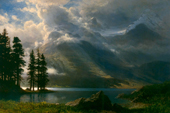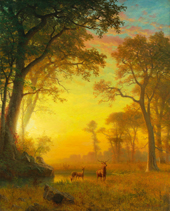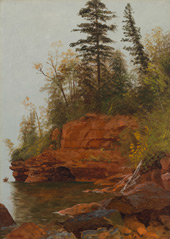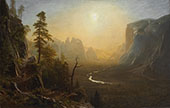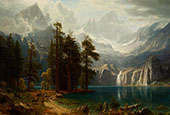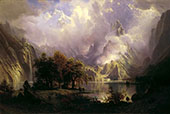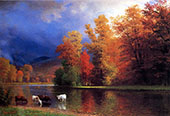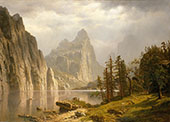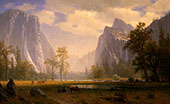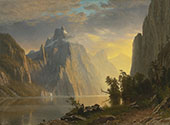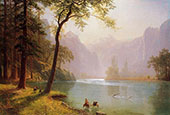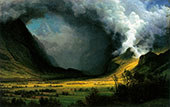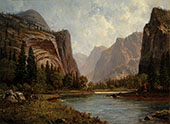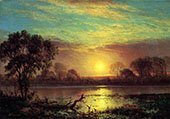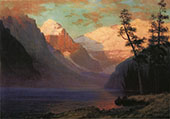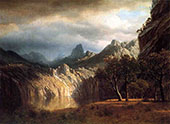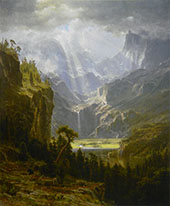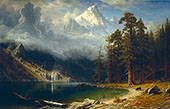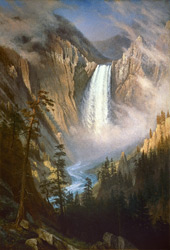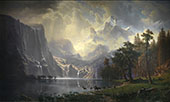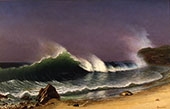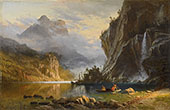Albert Bierstadt Oil Painting Reproductions
Albert Bierstadt replica paintings on Canvas for sale
Albert Bierstadt Paintings: An Artistic Biography
Albert Bierstadt's paintings are some of the most Romantic paintings in American history. His vast, sweeping Landscape Oil Paintings, often depicting the American West, have mesmerized art lovers for generations.
But who was Albert Bierstadt? This brief introduction explores his paintings and his involvement with the Hudson River School. We also delve further into his intriguing personal life.
When was Albert Bierstadt born?
Albert Bierstadt was born in Solingen in the Rhine Province, Germany, on January 7th, 1830, although his youth was not spent in Germany. When he was a year old, Bierstadt’s parents, Christina Tillmans and Henry Bierstadt, moved to Massachusetts, USA, setting up a home in New Bedford. As a child, Bierstadt displayed a precocious talent for art, developing a love for painting and drawing creating several crayon sketches.
Following his passion, he traveled to his German homelands as a young man. During 1853, he studied painting in Dusseldorf, and upon his return to America in 1857, he taught drawing and painting. However, he soon tired of teaching and devoted his time exclusively to oil painting.
What was Hudson River School art?
Hudson River School art refers to a group of artists working in the mid-19th century. Romanticism paintings strongly influenced these artists, and their paintings often depict the Hudson River Valley and the surrounding landscapes. Many Hudson River artists, including Albert Bierstadt, feature a glowing natural light in their paintings. This technique is linked with the Luminism art movement.
Bierstadt started by depicting views of Upstate New York and the Hudson River Valley during the late 1850s and 1860s. During this period, he met fellow artists Thomas Cole and Thomas Moran, whose oil paintings also included sweeping panoramic views of the American landscape.
His painting style is incredibly detailed and precise. Oil paintings often started with pencil sketches, multiple oil studies, and reference photographs.
Art Historians sometimes describe Albert Bierstadt paintings as “portraiture” for the landscape art genre. Indeed, Bierstadt’s landscape paintings are always faithful to reality but retain an element of idealism and beauty.
Aside from his paintings of the Hudson River Valley, Bierstadt was also a part of the Rocky Mountain School. Rocky Mountain paintings include Storm in the Rocky Mountains, Mount Rosalie 1866, and Evening Glow, Lake Louise.
What subject matter did Albert Bierstadt paint?
Albert Bierstadt famous paintings are known for their expansive and panoramic views of the American landscape.
In 1859, the artist traveled westwards with the Land Surveyor Frederick W. Lander, with both men soaking up inspiration. Upon his return from this trip, he resumed painting in his New York Studio, where he worked on sketches produced during these travels. These sketches result in some genuinely remarkable oil paintings of Western American landscapes. Albert Bierstadt paintings often feature the great American National Parks and Native American Reserves and their wild animals with serene lakes.
By 1863, Bierstadt yearned for more adventure. So he traveled again, this time with Fritz Hugh Ludlow, spending time in Yosemite Valley. This trip proved a turning point in his career, whose awe-inspiring landscapes resulted in some of his most famous paintings.
Looking up the Yosemite Valley, Merced River Yosemite, and Yosemite Valley Glacier Point Trail are oil on canvas artworks arising from this adventure. Albert Bierstadt's Yosemite Valley paintings embody and define this beautiful national park today. These paintings establish Bierstadt's reputation for beautiful Romantic images created with extreme technical skill.
Several other adventurers and explorers requested Bierstadt join them on later westward excursions. Towards the end of 1869, The Santa Fe Railroad commissioned the artist to paint the Grand Canyon and the surrounding Arizona landscapes.
How many paintings did Albert Bierstadt paint?
Art Historians have not determined precisely how many paintings Bierstadt created, but estimates range from 500 to over 4,000 drawings and paintings. As well as his paintings of the Yosemite Valley, he also created several legendary paintings of the Sierra Nevada. These artworks include Sierra Nevada 1871 and Lake in the Sierra Nevada 1867.
Albert Bierstadt's oil on canvas painting, Among the Sierra Nevada 1868, is the best-known of these creations. Intriguingly, however, Bierstadt painted Among the Sierra Nevada in his Rome studio. Today, this painting appears in the Smithsonian American Art Museum.
In 1867 Albert Bierstadt returned to Europe, visiting London, where he exhibited two large landscape paintings for Queen Victoria. After this success, he traveled through continental Europe to paint landscapes. Bierstadt’s oil paintings were particularly popular with European audiences. In an age of increasing emigration to the USA, they furthered narratives of America as a land where dreams come true.
Why is Albert Bierstadt important?
Albert Bierstadt's art presents profoundly influential views of the American West. His paintings represent the American dream of prosperity and exploration during a time of westward expansion and discovery.
Although Albert Bierstadt was not the first to paint these impressive landscapes, he brought extreme technical ability and artistic training to these beautiful settings. However, during his lifetime, contemporaries criticized his work as over-romanticizing the landscape. In addition, his use of Luminism appeared excessive to some, with others objecting to the artist's inclusion of Native American people.
Bierstadt’s wife, Rosalie, suffered from tuberculosis in 1876. As a result, the couple traveled to the Bahamas, seeking warmer climates. He lived on these islands until Rosalie died in 1893. However, he kept painting, producing works such as After a Norther, Bahamas c1878.
Albert Bierstadt continued traveling for work, moving between the Bahamas, his New York Studio, Canada, and the Western United States. In 1882 a fire swept through Bierstadt’s New York studio, destroying many of his oil paintings.
Where is Albert Bierstadt buried?
The artist died on 18 February 1902, with friends and family burying the artist at a New Bedford, Massachusetts cemetery. Due to his work falling out of critical favor, Albert Bierstadt paintings remained forgotten for most of the 20th century. Nonetheless, his famous landscape paintings have experienced a resurgence in recent years.
Many scholars note the importance of his landscapes in creating support and publicity for the American conservation movement. His depictions of Yellowstone, as seen in Yellowstone Falls and his Yosemite paintings, were integral to the foundation of the Yellowstone and Yosemite National Parks.
Albert Bierstadt Paintings: Hudson River School Art
If you love Albert Bierstadt’s stunningly romantic landscape paintings, please explore our extensive replica art collection. As well as Albert Bierstadt oil painting reproductions, discover other leading Hudson River School paintings by famous artists Thomas Cole and Martin Johnson Heade.
Cannot Find What You Are Looking For?
Reproduction Gallery Information
Customer Service
(Send Us A Message)
Tel: (503) 937 2010
Fax: (503) 937 2011


